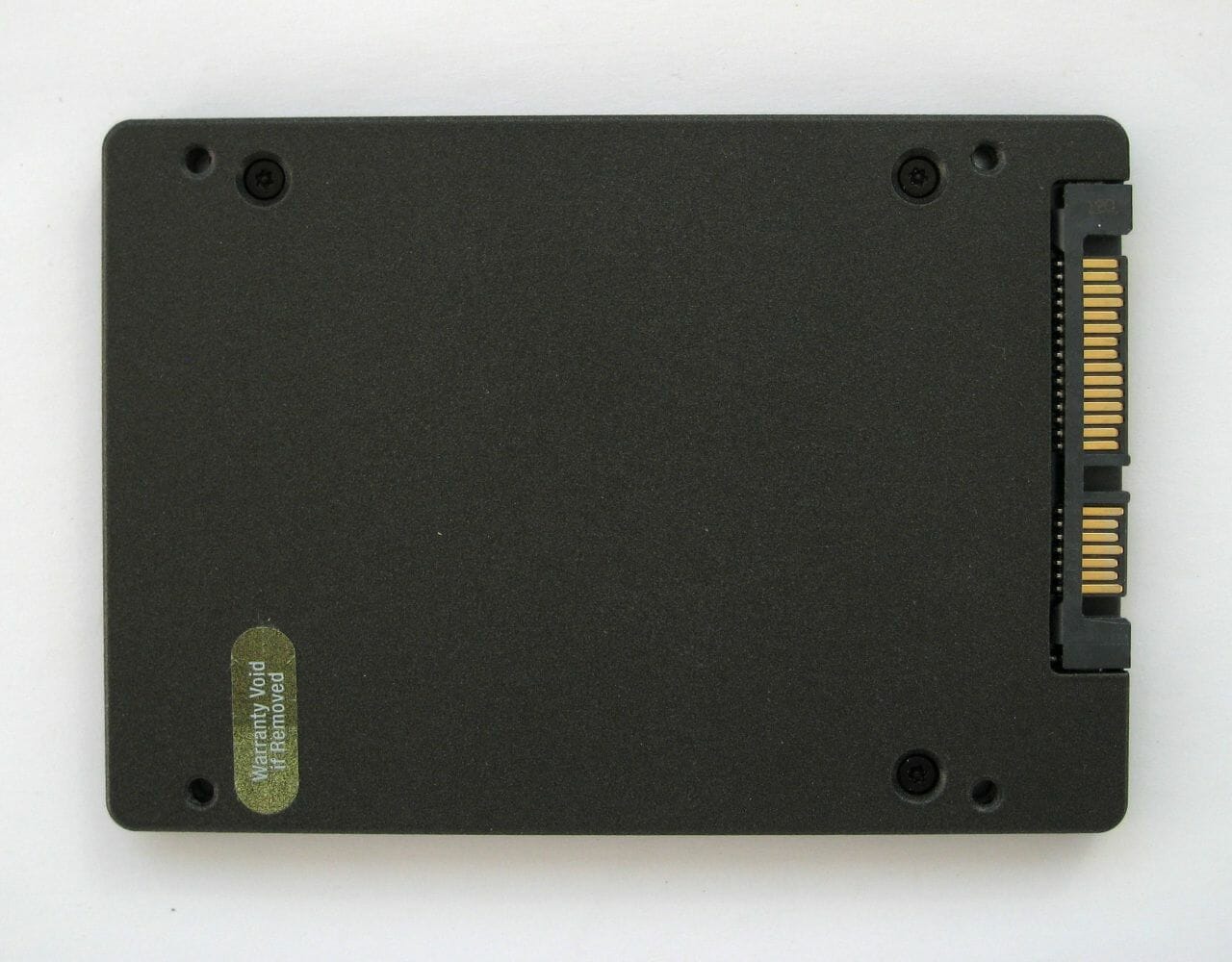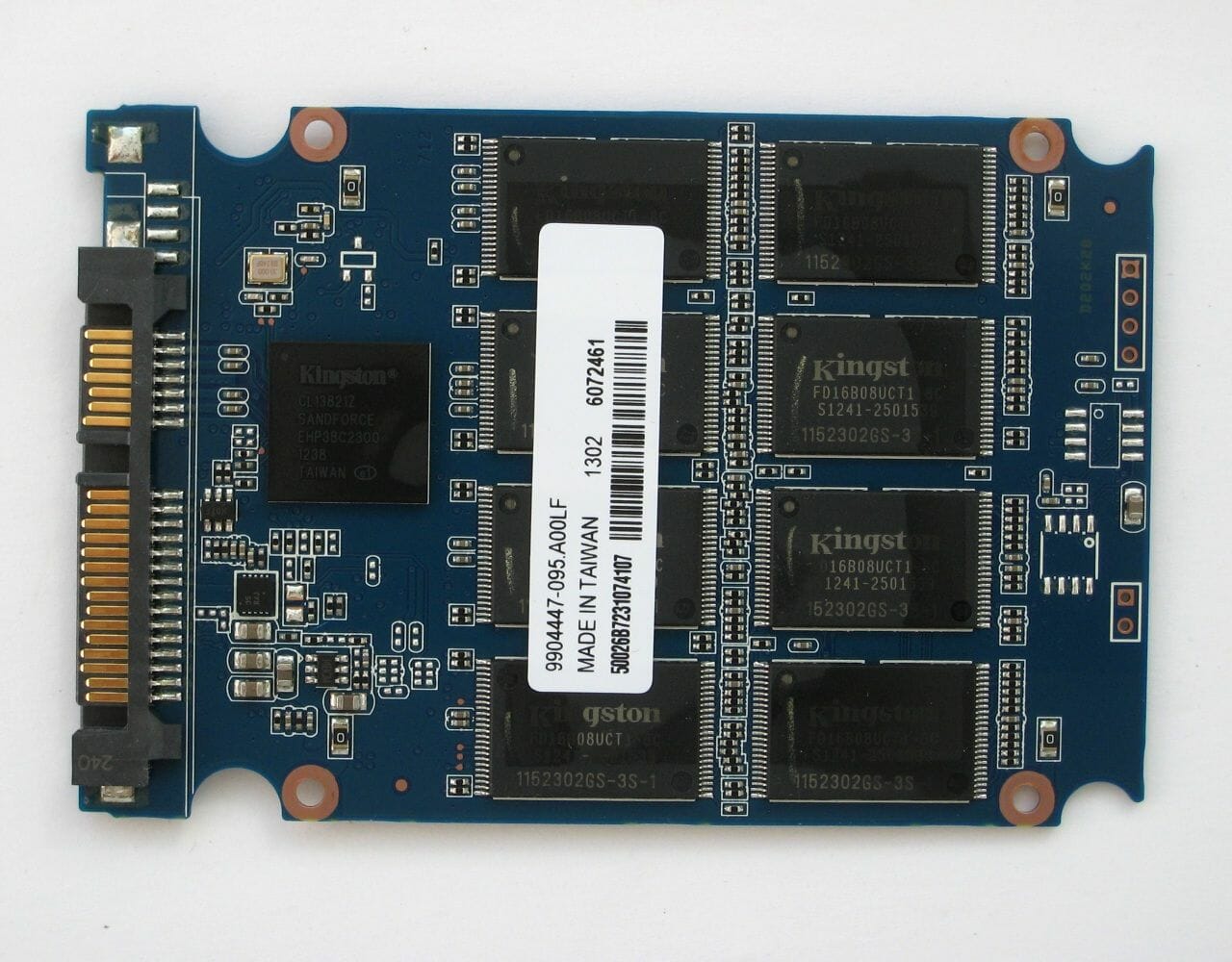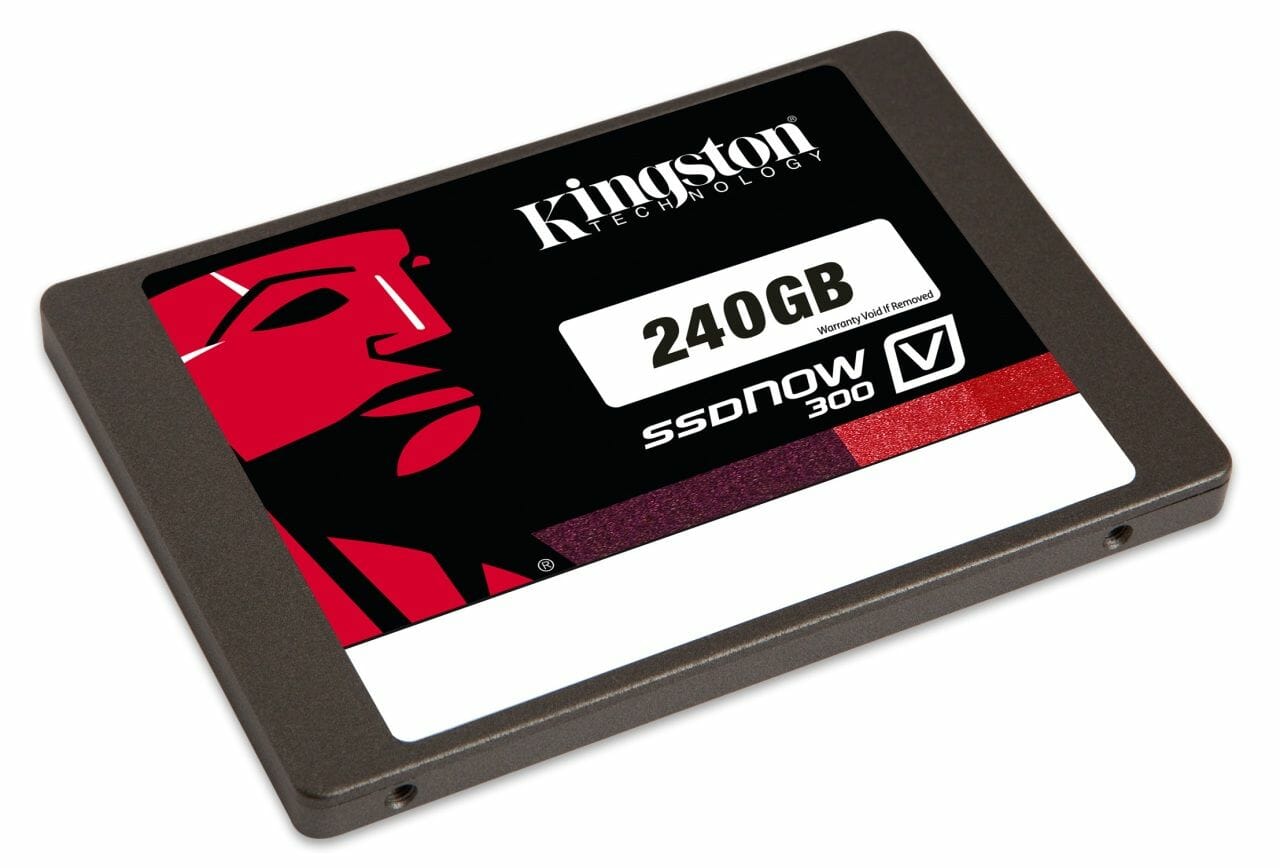Kingston SSDNow V300 Solid State Drive Review

You may have the impression that solid state drives on LSI SF-2281 controller have already been studied and tested inside out. However, Kingston managed to come up with a product that turned out genuinely surprising in the most positive way.
Unless you’re interested in solid state drives and keep track of all relevant news, the SSD market may seem to have been uneventful recently. This impression arises because of the limited number of SSD controllers available. The Samsung 840, Plextor M5 Pro and OCZ Vector, representing the Samsung MDX, Marvell 88SS9187 and Indilinx Barefoot 3 platform, respectively, are not new products, yet they remain leaders in terms of performance with no challengers in sight. There are just no newer controllers for consumer-class SSDs. Moreover, it has become tricky to increase performance which is often limited by the SATA3 interface bandwidth.
On the other hand, the lack of quick and clear progress is beneficial for end-users as it leads to price wars and, eventually, to cheaper products. Well, the manufacturers of flagship SSDs do not have to play with the price factor. Such products are attractive for their speed characteristics alone. So it is second-tier SSDs from companies that don’t have vast engineering resources that call for more flexible pricing. We mean the numerous firms that chose LSI with its SandForce controllers as their partner. The newest SF-2281 controller is actually over 2 years old, so it doesn’t look as impressive against the competition as right after its release. It is quite a notable trend that SandForce-based SSDs have been getting cheaper. Considering the lack of other news, it can make the subject of this review.
Besides the lowering price, we can see a whole new class of inexpensive SandForce-based SSDs emerge. They used to be made out of cheap MLC flash memory with asynchronous interface, the SF-2281 controller trying to mask its low speed by means of on-the-fly data compression. Such SATA3 SSDs got very popular and were the first to reach the psychological barrier of $1 per gigabyte of storage. But today asynchronous flash is becoming a thing of the past. It’s not good manners on the part of the SSD manufacturer to use it because there are other options available, the faster flash with synchronous interface having got cheaper after the introduction of new manufacturing technologies. As a result, there appear entry-level SSDs whose components would have made a top-performance product but recently.
We can trace this evolution through the products of Kingston, a company that only employs the SF-2281 controller for its SSDs. The SSDNow V+200 series with asynchronous flash has been phased out and replaced with the new SSDNow V300 which, to our surprise, features one of the newest types of MLC NAND flash with synchronous interface. It is going to be a very exciting product with a low price but rather high performance. But is it really possible? We’ll check this out by testing a 240GB Kingston SSDNow V300 and comparing it with the Kingston HyperX 3K which, despite the recent changes, is still positioned by the manufacturer as a mainstream solution.
Closer Look at Kingston SSDNow V300 240GB
Kingston pays close attention not only to the quality of products but also to the way they are presented to the customer. That’s why the company often offers its solutions in several versions. The Kingston SSDNow V300, for example, is available in as many as four: as a standalone SSD or as part of an upgrade kit. Of course, the standalone version seems to be the most interesting since it is less expensive, which is important for an entry-level product. It is simple: the SSD is just packed into a plastic blister wrap together with a paper insert that shows basic specifications.
Besides the SSD, there is also a plastic frame inside the wrap. You can glue it to the drive to increase its height from 7 to 9.5 millimeters if necessary. Thus, the SSDNow V300 is compatible with any 2.5-inch bay, both ultra-slim and regular ones.

Besides the reduced height, the SSDNow V300 doesn’t seem to be much different visually from its predecessor SSDNow V+200. The case is still made of steel with gray asphalt-like coating. The large sticker on the face side of the drive is designed in the same way. So, the product is easily recognizable as belonging to the SSDNow series.

Kingston’s characteristic attention to details can be noticed inside the case. The halves of the case are neatly fitted together and there’s a layer of stiff heat-conductive material inside, between the PCB and the case, to ensure proper cooling.
The PCB itself is somewhat unusual. It has the same component layout as other PCBs of SandForce-based drives but all the chips bear the Kingston logo. We’ve seen such rebranding with flash memory chips before (it usually means that the SSD maker buys them as uncut wafers and packages semiconductor dies into chips on its own facilities) but we’ve never dealt with rebranded SSD controllers. There is no doubt that it is the ubiquitous LSI SF-2281, however, as is indicated by the word SANDFORCE below the Kingston logo.

As for the memory chips, the line “FD16B08UCT1-8C” doesn’t give us any clue as to their origin but we know that the SSDNow V300 employs MLC flash memory manufactured on 19nm tech process. It can only be MLC NAND flash from Toshiba with synchronous Toggle Mode interface. It is a very high-speed type of memory which is used in the world’s best consumer-class SSDs such as Corsair Neutron GTX or Plextor M5 Pro. Frankly speaking, it’s a surprise to see such chips in the entry-level SSDNow V300 series but it makes the product even more interesting, especially as we don’t think that such premium memory will stay long in entry-level SSDs. It is likely to be replaced with cheaper TLC NAND in the near future but the firmware for SF-2281 controller doesn’t yet support TLC NAND.
We don’t know how Kingston makes it but the SSDNow V300 series is very inexpensive considering the components employed. It is most attractive in terms of price/performance ratio. There is only one disturbing fact about it or, to be specific, about its characteristics. The peculiarities of SandForce controllers provide some flexibility for the manufacturers, so they often specify higher-than-average speeds. It’s different with the Kingston SSDNow V300. The official specs of the 240GB model are as follows:
- Controller: SandForce SF-2281;
- Interface: SATA 6 Gbps;
- Flash-memory: synchronous 19 nm Toggle Mode MLC NAND;
- Size: 240 GB;
- Cache-memory: none;
- Sequential read speed: up to 450 MB/s;
- Sequential write speed: up to 450 MB/s;
- Random read speed (4 KB blocks): 85,000 IOPS
- Random write speed (4 KB blocks): 43,000 IOPS.
So the Kingston SSDNow V300 looks worse than the HyperX 3K and even than its predecessor SSDNow V+200 (which employed asynchronous flash) in terms of its specified sequential speeds. This may be due to some pricing issues, though.
There’s another oddity about the Kingston SSDNow V300: its specified service life is shorter compared to the HyperX 3K and the SSDNow V+200. The manufacturer guaranteed up to 192 terabytes of written data for its last-generation 240GB SSDs but the SSDNow V300 240GB is only expected to write up to 128 terabytes. We can think of two reasons for that. The SSD may use flash memory chips with a service life of 2000 rewrite cycles or it may all be due to some marketing measures. To clarify this aspect we turned to Kingston for help but received a very vague comment, which doesn’t really explain the real reasons for this phenomenon well enough:
“Kingston uses its own wafer processing capabilities to package the 19nm MLC NAND components for the V300 SSD. Typically, P/E cycles and yield increase as the wafer process matures and this is inherent in the NAND Flash being used in this product. As with all of our SSDs the TBW numbers we publish are conservative, and with DuraWrite technology, those numbers can easily triple for a typical consumer workload.”
It is quite possible that the low price of Kingston’s new SSD series is due to inferior-quality flash memory the manufacturer can get from Toshiba at a lower price, especially as the SandForce controller’s technologies help make use of such components without any negative effects for the end-user. That’s why the capacity is 240 rather than 256 gigabytes, by the way. The remaining storage is allotted for the reserve pool and the RAISE technology. That must be the reason why the SSDNow V300 comes with a 3-year warranty.
So, even though the new Kingston belongs to the SandForce family, it is not an ordinary representative of it. There are no other SSDs with the same components as yet. The firmware is special, too. Like the Intel 520, the SSDNow V300 features customized firmware adapted for 19nm Toggle Mode flash. It shouldn’t differ much from other SandForce-based products, though, as its firmware is based on the reference one (version 5.0.5).
Testbed Configuration
For our today’s SSD test session we decided to slightly upgrade our traditional testbed. From now on we are going to use a unified system for our performance tests, which will be built on an Intel H77 based mainboard, which features two SATA 6 Gbit/s ports. We will use these ports to connect the tested SSDs.
As for the today’s testing participants, it is obvious that the new Kingston SSDNow V300 240 GB must be compared against different incarnations of the second generation Sand Force platform as well as against other popular SSDs. Therefore, you will see on the diagrams performance numbers for other products based on SandForce controller: Intel SSD 520, Corsair Force GS and Corsair Force GT, which is a total analogue of the Kingston HyperX 3K. Other platforms will be represented by the following participants: Corsair SSDs on LAMD LM87800 controller (Neutron GTX and Neutron), OCZ Vertex 4 on Indilinx Everest 2 controller, the newest OCZ Vector SSD on Indilinx Barefoot 3 controller, Crucial m4 on Marvell 9174, and Plextor SSDs on Marvell 9174 controller (M5S) and Marvell 9187 controller (M5 Pro). All above mentioned drives used synchronous MLC flash memory. In particular, Crucial m4, Corsair Force GT, Corsair Neutron, Intel SSD 520, OCZ Vertex 4, OCZ Vector and Plextor M5S use 25 nm IMFT memory with ONFI-interface. And Corsair Force GS, Corsair Neutron GTX and Plextor M5 Pro use Toggle Mode MLC NAND manufactured using 2x nm or 19 nm technology.
Overall our testbed was configured as follows:
- Intel Core i5-3470S (Ivy Bridge, 4 cores, 2.9 GHz, EIST and Turbo Boost turned off);
- Intel DH77DF mainboard (BIOS 0108);
- 2 x 2 GB DDR3-1333 SDRAM DIMM 9-9-9-24-1T;
- Crucial m4 256 GB system disk (CT256M4SSD2);
- Tested SSDs:
- Corsair Force GS Series 240 GB (CSSD-F240GBGS-BK, firmware version 5.03);
- Corsair Force GT Series 240 GB (CSSD-F240GBGT-BK, firmware version 5.03)
- Corsair Neutron GTX 240 GB (CSSD-N240GBGTX-BK, firmware version 2.06);
- Corsair Neutron 240 GB (CSSD-N240GB3-BK, firmware version 2.06);
- Crucial m4 256 GB (CT256M4SSD2, firmware version 070H);
- Intel SSD 520 240 GB (SSDSC2CW240A3K5, firmware version 400i);
- Kingston SSDNow V300 240 GB (SV300S37A/240G, firmware version 5.0.5);
- OCZ Vertex 4 256 GB (VTX4-25SAT3-256G, firmware version 1.5);
- OCZ Vector 256 GB (VTR1-25SAT3-256G, firmware version 2.0);
- Plextor M5S 256 GB (PX-256M5S, firmware version 1.03);
- Plextor M5 Pro 256 GB (PX-256M5P, firmware version 1.03).
- Microsoft Windows 7 SP1 Ultimate x64
- Drivers:
- Intel Chipset Driver 9.3.0.1026;
- Intel Graphics Media Accelerator Driver 15.22.54.2622;
- Intel Rapid Storage Technology 11.7.0.1013.
Performance
Random/Sequential Reading/Writing
We use Anvil’s Storage Utilities 1.0.51 to measure random and sequential speeds. The synthetic benchmark integrated into that software suite provides a good general picture as it allows to check out the key speed parameters of an SSD.
The results you see here refer to the fresh out-of-box performance of SSDs. Moreover, we use incompressible data, which is the least favorable scenario for the LSI SF-2281 controller that employs on-the-fly data compression. Our testing shows, however, that the compression algorithms do not have a big effect on the real-life performance of SandForce-based SSDs when applications use hard-to-compress data and the flash memory has a high-speed synchronous interface. Testing such SSDs with highly compressible data wouldn’t have any practical worth today.
But progress doesn’t rest and the results on the diagrams are a great illustration of this fact. We viewed SandForce-based SSDs as high-performance products just a year ago but now they do not deserve such positioning. Based on platforms introduced over the past year, the new generation of SSDs are ahead of the SF-2281 based solutions. Today, a SandForce-based SSD may only aspire to be a mainstream product irrespective of what flash memory it contains.
Meanwhile, the Kingston SSDNow V300 isn’t a typical representative of its class. It differs for the better from the majority of SandForce-based SSDs, almost matching the performance of the Intel 520 which is superior to its counterparts thanks to its exclusive firmware. The firmware customization from Kingston and LSI leads to very clear benefits for the end-user, making the SSDNow V300 one of the fastest SandForce-based solutions available. Interestingly, it is going to be faster than the more expensive Kingston HyperX 3K (which is the same as the Corsair Force GT) since the latter employs typical hardware components as well as reference firmware.
Performance Degradation, Garbage Collection and TRIM
Unfortunately, SSDs are not always as fast as in their “fresh” state. In most cases their performance goes down after some time and in real life we deal with completely different write speeds than what we see on the diagrams in the previous chapter of our review. The reason for this phenomenon is the following: as the SSD runs out of free pages in the flash memory, its controller has to clear memory page blocks before saving data into them, which causes substantial delays. Although, modern SSD controllers can alleviate the performance drop by erasing unused flash memory pages ahead of time, when idle. The corresponding procedures are usually performed in idle mode, when the controller can fully restore the SSD performance by clearing out the unused flash memory pages. They use two techniques for that: idle-time garbage collection and TRIM.
An SSD controller doesn’t know which memory pages contain user data and which are considered empty by the OS. It’s because removing a file doesn’t involve its actual physical removal. Instead, the corresponding memory is marked in the file system as available for writing into. So, an SSD controller can only pre-erase pages in the reserve pool (if it exists) which is not accessible by the OS. For a better solution of this problem, modern OSes have the TRIM command which improves the efficiency of garbage collection. TRIM enables the SSD controller to physically remove unneeded data so that the user didn’t feel a performance hit during subsequent write requests.
This is how it should be theoretically. In practice, however, SSDs differ in their garbage collection and TRIM support. That’s why we check out the performance hit an SSD suffers when transitioning from its out-of-box (the flash memory is clean) to used state. This test follows the SNIA SSSI TWG PTS guidelines, which means that we measure the speed of writing in four cases one by one: 1) when the SSD is in its out-of-box state, 2) after the SSD has been twice filled full with data, 3) after a 30-minute pause that allows the SSD controller to restore performance by means of data reorganization and garbage collection, and 4) after the SSD is cleaned logically by the TRIM-supporting OS.
We ran the tests in synthetic IOMeter 1.1.0 RC1 benchmark, where we measured random write speed when working with 4 KB data blocks aligned to flash memory pages at 32 requests queue depth. The test data were pseudo-random. The following diagram shows the history of the relative speed changes, where 100% refers to the SSD performance in “fresh-out-of-box” state.
As you can see in the diagram, the performance degradation problem only persists on SandForce-based SSDs. The others can restore their speed back to the original level after a TRIM command. That’s why the Kingston SSDNow V300, like all other SF-2281 based solutions, are better suited for a system disk rather than for storing user data. When files are constantly being rewritten, the SSD’s writing performance may plummet by a half, which is most annoying.
Background garbage collection doesn’t work well on the SandForce-based SSDs, too. Although they have a rather large reserve pool, their speed can only be restored, even though partially, in a TRIM-supporting environment. This remark is important for Windows XP (where TRIM isn’t supported at all), for Mac OS X (when you have to enable T
RIM), and for RAIDs (where TRIM depends on the RAID controller’s driver).Futuremark PCMark 7
The famous PCMark 7 includes a dedicated disk subsystem test which is based on real-life applications. The test reproduces disk usage scenarios in popular tasks and measures how fast they are executed. Starting from version 1.4.0, the PCMark 7 disk subsystem test issues raw performance results which do not count in any pauses in the request queue. New results are thus incompatible with old ones, but the differences between SSDs become more obvious. That’s why we use the new version of the test.
We ran PCMark 7 on “steady” SSDs, which is what they are going to be in actual computer systems most of the time. Their performance in this case is affected not only by their controller or flash memory speed but also by the efficiency of their internal algorithms that fight performance degradation.
Futuremark’s programmers seem to be very fond of SandForce-based SSDs. Using compressible data in the test traces, they help the SF-2281 controller get the highest performance rating. So it wouldn’t be correct to compare SandForce-based SSDs with others using PCMark 7, yet we can compare SSDs within each group. And the Kingston SSDNow V300 doesn’t look good in this comparison. It is slower than the other SandForce-based solutions, making us suspect some limitations in its firmware that show up in real-life applications. After all, the SSDNow V300 is an entry-level product and is expected to be slower than other solutions with the SF-2281 controller.
Now let’s check out the individual tests to get a more detailed picture of what our SSDs are capable of under various types of operational load.
The same goes for the individual PCMark 7 tests. The Kingston SSDNow V300 should only be compared with the Intel SSD 520, Corsair Force GT and Corsair Force GS. And it turns out to be slower than all of them. In fact, it can only match the other SF-2281 based solutions at sequential reading/writing, i.e. when processing multimedia files. When it comes to random-address access, the Kingston SSDNow V300 is worse than the other SSDs with the same controller.
Intel NAS Performance Toolkit
Intel NASPT is another disk sub-system test that uses real-life usage scenarios. Like PCMark 7, Intel NASPT reproduces predefined disk activity traces and measures how fast they are executed. However, the default traces are designed for network attached storage devices rather than for SSDs. Therefore during our test session we replace them with the specially developed SSD Benchmarking Suite which offers more relevant usage scenarios such as compressing and decompressing files, compiling large projects, copying files and folders, loading 3D game levels, installing software, batch-processing photos, searching a digital library for data, mass-launching applications, and transcoding video.
Like PCMark 7, this benchmark gives us a true-to-life illustration of disk subsystem performance. Here the SSDs are again tested in their “steady” state.
Intel NASPT seems to provide a more adequate picture of SSD performance and the SandForce-based products aren’t so incredibly fast here. However, we can see that the customized firmware helps the Intel 520 and the Kingston SSDNow V300 perform faster than the others. The SSDNow V300 is only slower than the recognized leaders in the diagram, so it turns out to be the fastest SF-2281 based solution available from Kingston right now.
Besides the average benchmark score, we would also like to offer you the results of individual usage scenarios, which will show where Kingston SSDNow V300 can really shine. Note that the data-transfer rate is higher than the SATA III interface bandwidth in some subtests. That’s because INASPT is a high-level test that uses standard Windows functions to access the disk subsystem. As a result, the OS caching mechanisms also affect the results.
The SF-2281 controller isn’t new, yet it’s not outdated yet. It can often rival other platforms in real-life applications, especially when there’s a lot of random-address reading to be done. That’s why a SandForce-based SSD is quite a good solution even today.
Compared to similar offers from other brands, the Kingston SSDNow V300 is a very good choice. It is just faster than common SandForce-based SSDs with 24nm or 25nm synchronous flash. In fact, it is only inferior to the Intel 520 which is bolstered by its customized firmware.
File Copy Speed
We use AS SSD version 1.7.4739.38088 test to benchmark the speed of copying files within a single partition the size of the whole SSD. The SSDs are tested in their steady state.
The Kingston SSDNow V300 is downright slow here, just like any other product with an SF-2281 controller inside. It might be expected since copying means reading and writing files concurrently. And while SandForce-based SSDs are good at reading, writing slows them down so they find themselves in the bottom part of the diagram.
Conclusion
Frankly speaking, we are rather wary of SandForce-based SSDs. Besides their past firmware flaws which took a lot of time to be corrected, we don’t like their susceptibility to performance degradation due to imperfect TRIM implementation whereas their on-the-fly data compression is only good from the marketing point of view as it allows their manufacturers to specify unrealistically high speeds. So as soon as there appeared serious alternatives, we preferred them to the SandForce platform.
The Kingston SSDNow V300 is a special case, though. It can even change our perception of the SandForce platform at large. Kingston has shifted priorities with this product, positioning it as an inexpensive rather than high-performance SSD yet equipping it with Toshiba’s fast 19nm MLC NAND flash memory with Toggle Mode interface. Moreover, the manufacturer has developed customized firmware which helps the SSDNow V300 perform almost as fast as the Intel 520 in real-life applications. As a result, this SSD sports a very attractive price per gigabyte of storage while being faster than most SandForce-based products. It is especially good and comparable to indisputable leaders in reads-heavy scenarios, for example at loads typical of a system disk. So, if you’re looking for the best price/performance ratio, the Kingston SSDNow V300 should be among the first on your list.

The only catch is that the SSDNow V300 has a shorter specified service life than other SSDs of its class. Although it’s justifiable for an inexpensive product, you should be aware of that.
To help you with your choice, we offer the following summary table with test results of various SSDs. It contains basic hardware information about SSDs we’ve tested so far and allows to quickly determine the general position of a particular model among its competitors in terms of relative performance.